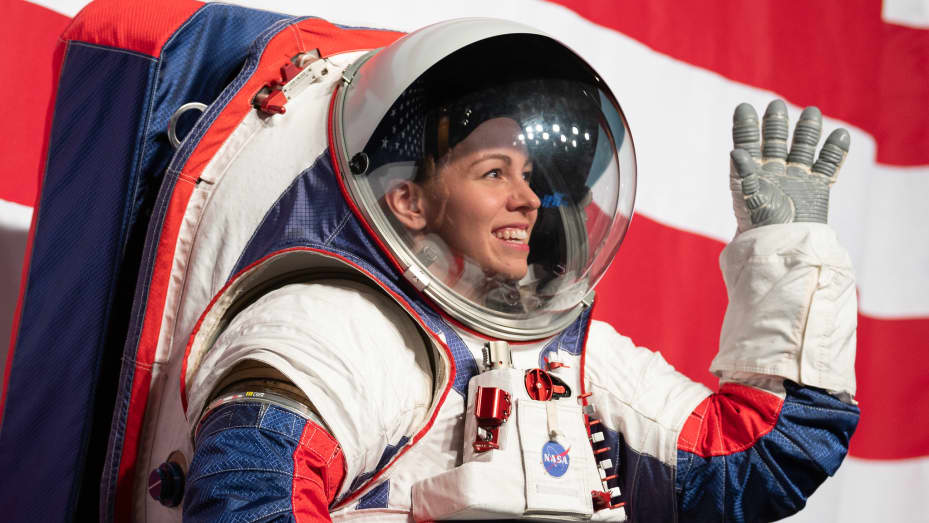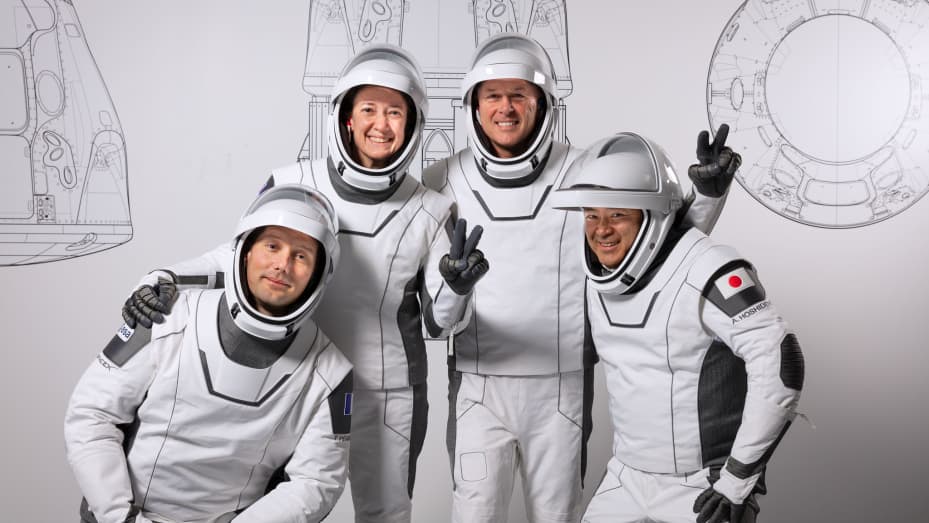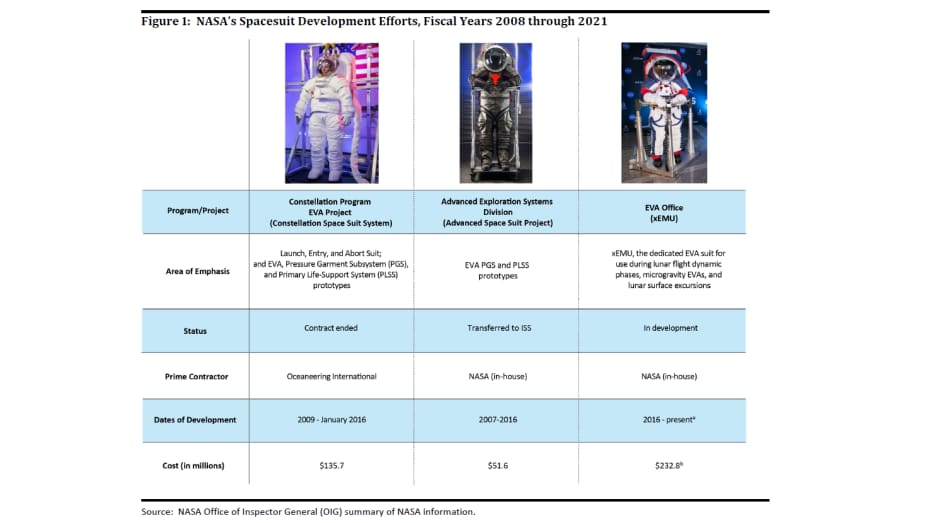The agency’s lunar-grade astronaut suits are behind schedule, an inspector general report says
By Joey Roulette Aug 10, 2021
/cdn.vox-cdn.com/uploads/chorus_image/image/69705199/1176110120.0.jpg)
The person in the white suit is wearing a prototype of NASA’s new xEMU in 2019, whose development has been delayed, an inspector general report found.
Photo by Joel Kowsky / NASA via Getty Images
NASA’s development of new astronaut space suits will be nearly two years late and nix its effort to land humans on the Moon by 2024, an inspector general report released on Tuesday found. Those delays compound a daunting set of schedule challenges NASA already faces — from the development of its new human-rated lunar lander to getting its massive Space Launch System rocket off the ground.
An audit from the agency’s Office of Inspector General said NASA is on track to spend more than $1 billion on space suit development by the time its first two suits are ready, which would be “April 2025 at the earliest,” the report said. “Given these anticipated delays in spacesuit development, a lunar landing in late 2024 as NASA currently plans is not feasible.”
NASA is trying to return astronauts to the surface of the Moon for the first time since 1972 under its Artemis program that was spawned by the Trump administration in 2019. The program, as set by former Vice President Mike Pence, called for a crewed lunar landing in 2024 — a deadline that President Biden’s transition team deemed unrealistic. But NASA continues to embrace the date, with administrator Bill Nelson insinuating delays are likely because “space is hard.”
NASA’s development of new astronaut space suits will be nearly two years late and nix its effort to land humans on the Moon by 2024, an inspector general report released on Tuesday found. Those delays compound a daunting set of schedule challenges NASA already faces — from the development of its new human-rated lunar lander to getting its massive Space Launch System rocket off the ground.
An audit from the agency’s Office of Inspector General said NASA is on track to spend more than $1 billion on space suit development by the time its first two suits are ready, which would be “April 2025 at the earliest,” the report said. “Given these anticipated delays in spacesuit development, a lunar landing in late 2024 as NASA currently plans is not feasible.”
NASA is trying to return astronauts to the surface of the Moon for the first time since 1972 under its Artemis program that was spawned by the Trump administration in 2019. The program, as set by former Vice President Mike Pence, called for a crewed lunar landing in 2024 — a deadline that President Biden’s transition team deemed unrealistic. But NASA continues to embrace the date, with administrator Bill Nelson insinuating delays are likely because “space is hard.”
NASA’S SPACE SUIT DESIGN HAS CHANGED WITH SHIFTING SPACE PRIORITIES, DRIVING UP COSTS AND DELAYS
NASA has already spent $420 million on space suit development since 2007, before the advent of its Artemis program, and it plans to “invest approximately $625.2 million more” through 2025, the report said. The space suit’s design and purpose have changed repeatedly over the years as NASA’s priorities in space teeter between new administrations. A new Artemis-tailored space suit design, called xEMU, was unveiled in 2019. Current suits worn by astronauts on the International Space Station are restrictive, haven’t been upgraded in decades, and aren’t designed for long walks on the Moon.
The xEMU program anticipated development delays by allotting 12 months of wiggle room on its path to meet the 2024 Artemis deadline. But that schedule margin has already disappeared after NASA ran into funding shortfalls, closures to NASA centers during the COVID-19 pandemic, and more technical challenges, the report found. NASA slashed the space suit program’s planned $209 million budget by $59 million after Congress gave the agency 77 percent of what it requested for its Gateway Program in 2021, under which space suits are developed. That set the program back three months, the report said.
:no_upscale()/cdn.vox-cdn.com/uploads/chorus_asset/file/22773878/1176165285.jpg)
NASA space suit engineer Kristine Davis models a prototype of the agency’s new lunar space suit in 2019. Photo by Xinhua / Liu Jie via Getty Images
Intermittent closures to NASA’s Johnson Space Center during the pandemic caused at least three more months of delays, the report said. Then there were the hardware problems. Design upgrades and other changes caused production issues with the suit’s Display and Control Unit — the screen astronauts will use to control the suit’s critical functions. Circuit boards within a key part of the suits’ life support system, needed “rework” to ensure communications between the suit and the astronaut — and other astronauts — worked right.
The program was hit with another delay when NASA halted testing for the suit’s assembly process. The team caused an unspecified “component failure” after “staff used the wrong specifications to build a complicated” life support system interface. When auditors interviewed NASA personnel about this flub, they blamed schedule pressure, among other issues. Additional factors included “a communication breakdown among the team” and the team’s rapid growth, “including the addition of inexperienced personnel.” An “unreleased drawing” and old hardware used during tests were also to blame, personnel told auditors.
Currently, 27 different entities are pitching in to build different parts of the space suit, the report notes. NASA previously contracted with just two companies, Hamilton Standard and ILC Dover, to build the space suits it currently uses on the ISS.
Intermittent closures to NASA’s Johnson Space Center during the pandemic caused at least three more months of delays, the report said. Then there were the hardware problems. Design upgrades and other changes caused production issues with the suit’s Display and Control Unit — the screen astronauts will use to control the suit’s critical functions. Circuit boards within a key part of the suits’ life support system, needed “rework” to ensure communications between the suit and the astronaut — and other astronauts — worked right.
The program was hit with another delay when NASA halted testing for the suit’s assembly process. The team caused an unspecified “component failure” after “staff used the wrong specifications to build a complicated” life support system interface. When auditors interviewed NASA personnel about this flub, they blamed schedule pressure, among other issues. Additional factors included “a communication breakdown among the team” and the team’s rapid growth, “including the addition of inexperienced personnel.” An “unreleased drawing” and old hardware used during tests were also to blame, personnel told auditors.
Currently, 27 different entities are pitching in to build different parts of the space suit, the report notes. NASA previously contracted with just two companies, Hamilton Standard and ILC Dover, to build the space suits it currently uses on the ISS.
“Seems like too many cooks in the kitchen,” SpaceX CEO Elon Musk opined on Twitter in response to the news, adding in another tweet: “SpaceX could do it if need be.” It’s unclear whether SpaceX has an active space suit development program; government astronauts who have flown the company’s Crew Dragon capsule wear SpaceX-designed flight suits, not long-duration space suits. Some private companies are already planning to design their own space suits, including Axiom Space, which, this month, posted new jobs for space suit engineers.
NASA’s space suit woes aren’t the only threat to its 2024 goal. The agency’s inspector general, Government Accountability Office, and NASA’s aerospace safety panel have all expressed concern that development delays in NASA’s human lunar lander and Space Launch System programs — the core organs of the Artemis program — will make a 2024 landing nearly impossible, with the safety panel raising fears that the hastened landing date could lead to schedule pressure among engineers.
In response to the report, NASA’s human exploration chief Kathy Lueders said the agency plans to rejig its space suit development schedule and carry out a space suit test on the ISS by June 2022, before the first crewed Artemis mission poised for sometime in 2023. For that mission, astronauts will fly around the Moon in NASA’s Orion capsule without a lunar landing. The next mission, Artemis III, will have the Moon landing.
“Demonstration and testing of [the space suits] on ISS are a priority,” Lueders said.
Elon Musk offers for SpaceX to make NASA spacesuits, after watchdog says program to cost $1 billion (PER SUIT!!)
PUBLISHED TUE, AUG 10 2021
Michael Sheetz@THESHEETZTWEETZ
KEY POINTS
Elon Musk offered SpaceX’s services to help NASA make its next-generation spacesuits.
His proposal came in response to a report by NASA’s inspector general on the work being done to develop a new line of Extravehicular Mobility Units, which are informally called spacesuits.
NASA has spent more than $420 million on spacesuit development since 2007 but, even with another $625 million in spending planned, the inspector general report found that the spacesuits for the agency’s lunar missions will “not be ready for flight until April 2025 at the earliest.”

Kristine Davis, a spacesuit engineer at NASA’s Johnson Space Center, wears a ground prototype of the new Exploration Extravehicular Mobility Unit (xEMU), during a demonstration on Oct. 15, 2019.
Joel Kowsky / NASA
Elon Musk offered SpaceX’s services to help NASA make its next-generation spacesuits, after a watchdog report on Tuesday said the agency’s current program is behind schedule and will cost more than $1 billion.
“SpaceX could do it if need be,” Musk wrote in a tweet.
Musk’s company has developed and made flight suits for astronauts who launch into orbit in SpaceX’s Crew Dragon spacecraft. The flight suits are primarily designed to protect the astronauts in case of a fire inside of the spacecraft, or if the cabin depressurizes. Building spacesuits would be a more complex and challenging endeavor, given the need to survive outside of a spacecraft in the harsh environment of space.
NASA spokesperson Monica Witt, in a statement to CNBC on Musk’s offer, pointed to the agency’s request last month to companies in the space industry for feedback on “purchasing commercial spacesuits, hardware, and services.”

From left: Mission specialist Thomas Pesquet of the ESA, pilot Megan McArthur of NASA, commander Shane Kimbrough of NASA, and mission specialist Akihiko Hoshide of JAXA.
SpaceX
Musk’s proposal came in response to a report by NASA’s inspector general – which is the investigative office which audits the agency for fraud and mismanagement – on the work being done to develop a new line of Extravehicular Mobility Units, which are informally called spacesuits.
Astronauts on board the International Space Station use spacesuits “designed 45 years ago for the Space Shuttle” program, the report noted. The IG also highlighted that those spacesuits have been “refurbished and partially redesigned” over the past decades to continue working.
The space agency has started three different spacesuit programs since 2007, the inspector general found, and has spent $420.1 million on development since then. Additionally, the report said NASA “plans to invest approximately $625.2 million more” on development, testing and qualification to complete a suit for a demonstration on the ISS and two suits for the crewed mission to the moon – for a total cost of “over $1 billion” through 2025.

NASA Inspector General
Beyond the soaring cost, the inspector general said delays “attributable to funding shortfalls, COVID-19 impacts, and technical challenges” have eliminated the chance the spacesuits are ready in time. The spacesuits will “not be ready for flight until April 2025 at the earliest,” the report said. NASA originally said the spacesuits would be ready by March 2023.
NASA needs new spacesuits for its Artemis program, which was announced by former President Donald Trump’s administration and has continued under President Joe Biden. Artemis is expected to consist of multiple missions to the moon’s orbit and surface in the years ahead, with NASA aiming to land astronauts on the lunar body by 2024. Although NASA has stuck to the 2024 goal, the inspector general has warned repeatedly that the schedule is threatened by several major programs that are key to Artemis’ success.
Musk earlier this year called the 2024 timeline “actually doable,” after SpaceX became one of the critical pieces of Artemis by winning a $2.9 billion contract to use its Starship rocket to deliver astronauts to the moon’s surface.
The spacesuits have a multitude of different components, which the inspector general noted are supplied by 27 different companies. That’s a point Musk also highlighted, saying in a tweet that it “seems like too many cooks in the kitchen.”
SpaceX did not respond to CNBC’s request for comment on whether the company has begun work on its own spacesuits. While the company hasn’t publicly disclosed spacesuit plans, it is one of nearly 50 companies that expressed interest in NASA’s program to purchase privately developed spacesuits and spacewalk services.
Michael Sheetz@THESHEETZTWEETZ
KEY POINTS
Elon Musk offered SpaceX’s services to help NASA make its next-generation spacesuits.
His proposal came in response to a report by NASA’s inspector general on the work being done to develop a new line of Extravehicular Mobility Units, which are informally called spacesuits.
NASA has spent more than $420 million on spacesuit development since 2007 but, even with another $625 million in spending planned, the inspector general report found that the spacesuits for the agency’s lunar missions will “not be ready for flight until April 2025 at the earliest.”

Kristine Davis, a spacesuit engineer at NASA’s Johnson Space Center, wears a ground prototype of the new Exploration Extravehicular Mobility Unit (xEMU), during a demonstration on Oct. 15, 2019.
Joel Kowsky / NASA
Elon Musk offered SpaceX’s services to help NASA make its next-generation spacesuits, after a watchdog report on Tuesday said the agency’s current program is behind schedule and will cost more than $1 billion.
“SpaceX could do it if need be,” Musk wrote in a tweet.
Musk’s company has developed and made flight suits for astronauts who launch into orbit in SpaceX’s Crew Dragon spacecraft. The flight suits are primarily designed to protect the astronauts in case of a fire inside of the spacecraft, or if the cabin depressurizes. Building spacesuits would be a more complex and challenging endeavor, given the need to survive outside of a spacecraft in the harsh environment of space.
NASA spokesperson Monica Witt, in a statement to CNBC on Musk’s offer, pointed to the agency’s request last month to companies in the space industry for feedback on “purchasing commercial spacesuits, hardware, and services.”

From left: Mission specialist Thomas Pesquet of the ESA, pilot Megan McArthur of NASA, commander Shane Kimbrough of NASA, and mission specialist Akihiko Hoshide of JAXA.
SpaceX
Musk’s proposal came in response to a report by NASA’s inspector general – which is the investigative office which audits the agency for fraud and mismanagement – on the work being done to develop a new line of Extravehicular Mobility Units, which are informally called spacesuits.
Astronauts on board the International Space Station use spacesuits “designed 45 years ago for the Space Shuttle” program, the report noted. The IG also highlighted that those spacesuits have been “refurbished and partially redesigned” over the past decades to continue working.
The space agency has started three different spacesuit programs since 2007, the inspector general found, and has spent $420.1 million on development since then. Additionally, the report said NASA “plans to invest approximately $625.2 million more” on development, testing and qualification to complete a suit for a demonstration on the ISS and two suits for the crewed mission to the moon – for a total cost of “over $1 billion” through 2025.

NASA Inspector General
Beyond the soaring cost, the inspector general said delays “attributable to funding shortfalls, COVID-19 impacts, and technical challenges” have eliminated the chance the spacesuits are ready in time. The spacesuits will “not be ready for flight until April 2025 at the earliest,” the report said. NASA originally said the spacesuits would be ready by March 2023.
NASA needs new spacesuits for its Artemis program, which was announced by former President Donald Trump’s administration and has continued under President Joe Biden. Artemis is expected to consist of multiple missions to the moon’s orbit and surface in the years ahead, with NASA aiming to land astronauts on the lunar body by 2024. Although NASA has stuck to the 2024 goal, the inspector general has warned repeatedly that the schedule is threatened by several major programs that are key to Artemis’ success.
Musk earlier this year called the 2024 timeline “actually doable,” after SpaceX became one of the critical pieces of Artemis by winning a $2.9 billion contract to use its Starship rocket to deliver astronauts to the moon’s surface.
The spacesuits have a multitude of different components, which the inspector general noted are supplied by 27 different companies. That’s a point Musk also highlighted, saying in a tweet that it “seems like too many cooks in the kitchen.”
No comments:
Post a Comment